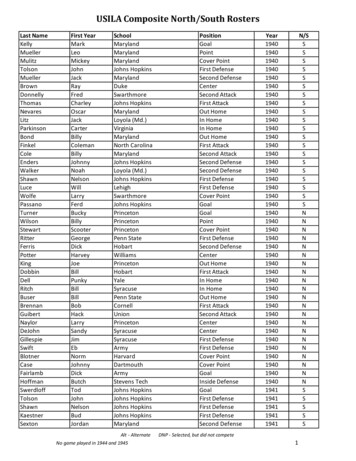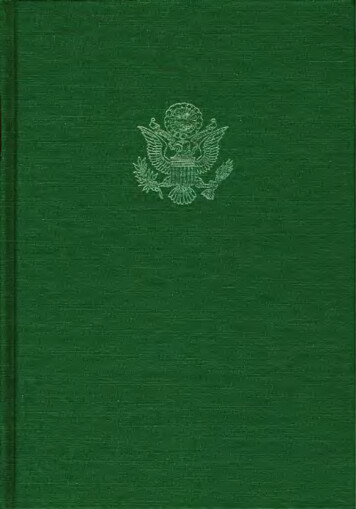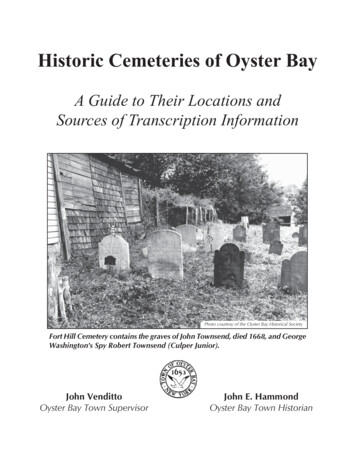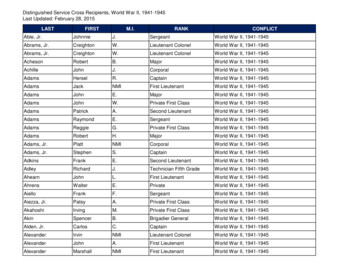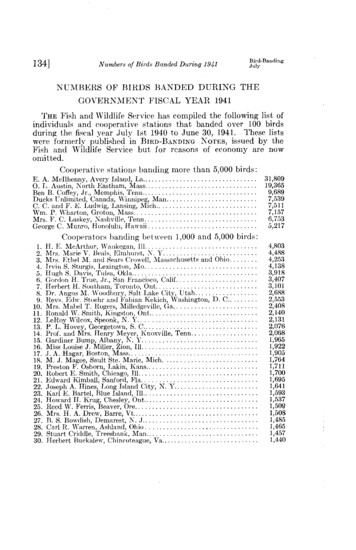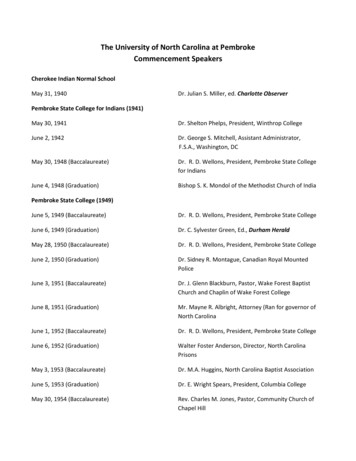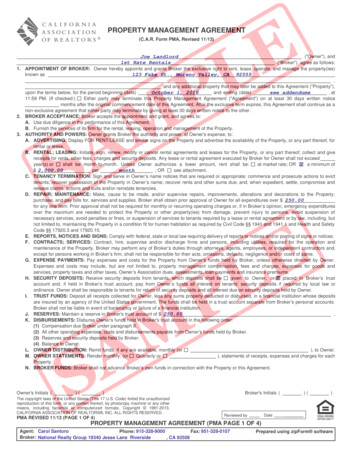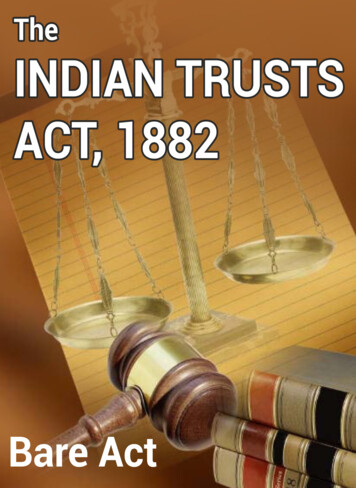
Transcription
1941–2021
ForewordThe individuals who have held the highest officeThe profiles depict the 27 leaders in the context ofin the Central Intelligence Agency are an eclectictheir times, describing their triumphs and setbacks,group. They include two Rhodes Scholars and a col-not in isolation but as elements in a larger drama oflege dropout, captains of industry, and career publicdomestic politics and foreign affairs. Their storiesservants, as well as Agency veterans and newcomersare inspiring, sometimes sobering, and always fasci-to the field of intelligence. Seventy-five years afternating. They also feature, of course, the controversythe Agency was founded, there is still no establishedthat seems endemic to the sensitive and challengingroad to the top.work of intelligence.This is just one of the many themes presented in thisTaken together, these profiles offer an illuminatingrevealing look at the 27 leaders who have direct-account drawn from the full unclassified record. It ised the CIA and its forerunners from 1941 throughwritten in broad strokes but with enough detail to2021. The publication opens with a profile of Majorspark the kind of informed debate that has alwaysGeneral William J. Donovan—the legendary intelli-been a hallmark of the CIA. Since its inception, thegence chief who ran the Office of Strategic Services,Agency has been rooted in a culture of inquiry anda precursor of the CIA during World War II—andconstant self-examination. This work stands as athose of two other intelligence pioneers who, likefine example of that honorable tradition.Donovan, never served at the CIA but helped laythe groundwork for its foundation. The publicationthen traces the careers of the Directors of CentralIntelligence until that title was replaced in 2005 withDirector of the Central Intelligence Agency, afterthe establishment of the Office of the Director ofNational Intelligence.4/5
TableofContents8Directors Timeline6610William J. Donovan,Major General, US ArmyStansfield TurnerAdmiral, US Navy70William J. Casey76William H. Webster80Robert M. Gates14Sidney W. SouersRear Admiral, US Naval Reserve18Hoyt S. Vandenberg,Lieutenant General, US Army84R. James Woolsey22Roscoe H. HillenkoetterRear Admiral, US Navy88John M. Deutch92George J. Tenet26Walter Bedell SmithGeneral, US Army98Porter J. Goss10230Allen W. DullesMichael V. HaydenGeneral, US Air Force36John A. McCone106Leon E. Panetta40William F. Raborn Jr.Vice Admiral, US Navy (Ret.)110David H. PetraeusGeneral, US Army (Ret.)44Richard M. Helms114John O. Brennan50James R. Schlesinger120Michael R. Pompeo54William E. Colby126Gina HaspelGeorge H. W. Bush132William J. Burns606/7
D i r e ct o r s T i m e l i n e19401960William J. Donovan1William F. Raborn Jr.4Major General, US ArmyJul 11, 1941 – Jun 13, 1942 (COI)Jun 13, 1942 – Oct 1, 1945 (OSS)Vice Admiral, US NavyDCI, Apr28, 1965 – Jun 30, 1966Sidney W. Souers2Richard M. HelmsRear Admiral, US Naval ReserveDCI, Jan 23, 1946 – Jun 10, 1946 (CIG)DCI, Jun 30, 1966 – Feb 2, 1973Hoyt S. Vandenberg2James R. SchlesingerLieutenant General, US ArmyDCI, Jun 10, 1946 – May 1, 1947 (CIG)DCI, Feb 2, 1973 – Jul 2, 197319501970Roscoe H. Hillenkoetter3William E. ColbyRear Admiral, US NavyDCI, May 1, 1947 – Oct 7, 1950DCI, Sep 4, 1973 – Jan 30, 1976Walter Bedell SmithGeorge H.W. BushGeneral, US Army (Army Air Forces)DCI, Oct 7, 1950 – Feb 9, 1953DCI, Jan 30, 1976 – Jan 20, 1977Stansfield Turner5Admiral, US NavyDCI, Mar 9, 1977 – Jan 20, 1981Allen W. DullesDCI, Feb 26, 1953 – Nov 29, 196119601980John A. McCone1.President Franklin D. Roosevelt nominated Donovan to the position of Coordinatorof Information (COI) on July 11, 1941, creating the nation’s first peacetime, nondepartmental intelligence organization. On June 13, 1942, COI was thensuperseded by the Office of Strategic Services, which had a mandate to collect and analyzestrategic information and conduct counterintelligence operations during World War II.William J. CaseyDCI, Jan 28, 1981 – Jan 29, 1987DCI, Nov 29, 1961 – Apr 28, 19652Before the National Security Act of 1947 established the CIA on September 18, 1947, the Director of Central Intelligence (DCI) served as a member of the National Intelligence Authority and head of the Central Intelligence Group (CIG) by authority of a Presidential Directiveof January 22, 1946.3The National Security Act of 1947 established the CIA, which replaced the CIG on September18, 1947.
19802010David H. Petraeus8William H. WebsterGeneral, US ArmyD/CIA, Sep 6, 2011 – Nov 9, 2012DCI, May 26, 1987 – Aug 31, 1991Robert M. GatesDCI, Nov 6, 1991 – Jan 20, 1993Leon E. PanettaD/CIA, Feb 13, 2009 – Jun 30, 2011R. James WoolseyDCI, Feb 5, 1993 – Jan 10, 1995John O. BrennanD/CIA, Mar 8, 2013 – Jan 23, 201719902020John M. DeutchDCI, May 10, 1995 – Dec 15, 1996Michael R. PompeoD/CIA, Jan 23, 2017 - Jul 6 2018George J. TenetDCI, Jul 11, 1997 – Jul 11, 2004Gina HaspelPorter J. Goss6D/CIA, May 18, 2018 – Jan 20, 2021DCI, Sep 24, 2004 – Apr 21, 2005D/CIA, Apr 21, 2005 – May 26, 20062000Michael V. Hayden72021General, US Air ForceD/CIA, May 30, 2006 – Feb 13, 2009William J. BurnsD/CIA, Mar 1, 2021 – Present4Raborn retired from the US Navy on September 1, 1963.7Hayden retired from the US Air Force on July 1, 2008, while serving as D/CIA.5Turner retired from the US Navy on December 31, 1978, while serving as DCI.8Petraeus retired from the US Army on August 31, 2011.6The Intelligence Reform and Terrorism Prevention Act (IRTPA) of 2004 abolished the position of DCI and created the position of Director of the Central Intelligence Agency (D/CIA).
WilliamJosephDonovanMajor General, US ArmyTenure:Coordinator of Information, July 11, 1941— June 13, 1942Director, Office of Strategic Services, June 13, 1942—October 1, 1945Presidents Served:Franklin D. RooseveltHarry S. TrumanAppointed: July 11, 1941, by President Franklin D. Roosevelt as Coordinator ofInformation June 13, 1942, by President Franklin D. Roosevelt as Director of StrategicServicesBorn:January 1, 1883, Buffalo, New YorkE du c a t i o n :Attended Niagara College, 1903; Columbia University, B.A., 1905;Columbia University Law School, LL.B., 1907Career Highlights: Served with New York National Guard on Mexican border, 1916, and with165th Infantry (69th New York) Regiment in World War I; awarded Medalof Honor in 1923 for bravery in 1918 Second Battle of the Marne Assistant US Attorney General, 1924-29 Practiced law in New York, 1929-41 Republican nominee for Governor of New York, 1932 Placed on active duty and appointed Brigadier General in US Army, 1943 Promoted to Major General, 1944 Released from US Army, 1946 Practiced law in New York, 1946-53 Ambassador to Thailand, 1953-54D i e d : February 8, 195910 / 11
As US involvement in World War II appearedthe Second Battle of the Marne in September 1918.increasingly likely, President Franklin D. RooseveltHe was also awarded the Distinguished Servicerecognized that America urgently needed to pieceCross and two Purple Hearts.together the fragmented intelligence organizationsacross the US Government to bring focus, context,In 1940, with Britain standing alone against Naziand clarity to the information reaching the WhiteGermany, President Roosevelt asked Donovan, hisHouse. To lead the effort, he turned to William J.former classmate at Columbia Law School, to trav-Donovan—one of the most decorated US soldiersel to England to determine whether Britain wouldin World War I—asking him in July 1941 to beginbe able to withstand the Nazi onslaught. Donovanlaying the groundwork for what would becomereported that the British could stand firm if givenAmerica’s first centralized intelligence organization.enough aid. While conducting his inquiry, Donovandeveloped a deep appreciation of British intelligenceDonovan’s military experience and keen interest inoperations, which heightened his interest in estab-intelligence and foreign affairs made him uniquelylishing an American intelligence organization mod-qualified for the job. During World War I, Donovaneled on the British system.led the 165th Regiment of the US Army, gaining thenickname “Wild Bill” for putting his men throughPresident Roosevelt, impressed by Donovan’sgrueling training drills to prepare them for battle.views on intelligence, asked him to take the lead inHe was wounded in action three times and earnedcentralizing the nation’s intelligence efforts. Onthe Medal of Honor for bravery under fire duringJuly 11, 1941, he named Donovan to the positionof Coordinator of Information (COI) to direct asmall civilian intelligence unit that consolidated information collected abroad for review by the President. Within months, America’s entry into WorldWar II prompted a reassessment of the COI, and inJune 1942 the bulk of its mission was transferred toa new intelligence organization, the Office of Strategic Services (OSS).Donovan became Director of the OSS, envisioningit as a strategic intelligence center encompassing collection, research and analysis, counterintelligence,and paramilitary activities. Throughout World WarII, the OSS engaged in espionage and sabotage operations in Europe, the Middle East, North Africa,and East Asia. Donovan’s vision for the OSS formed“Wild Bill” Donovan’s favorite picture of himself, taken inSeptember 1918.the basis for the future CIA and it shaped the role,structure, and doctrine of America’s foreign intelli-
“Allmajor powers except theUnited Stateshave hadfor a long time past permanent worldwidei n t e l l i g e n c e s e r v i c e s , r e p o r t i n g d i r e ct l y t o t h e h i g h est echelons of theirGovernments. PriorUnited States had noservice. It never has hadto the presentwar, theforeign secret intelli-genceand does not now have acoordinated intelligence system.”- OSS Director Donovan to President Harry Truman, August 25, 1945,quoted in For the President’s Eyes Only (1995) by Christopher Andrewgence effort for decades to come. Four Directors ofCentral Intelligence (DCIs)—Allen Dulles, RichardHelms, William Colby, and William Casey—wereOSS veterans.By war’s end, Donovan was promoted to MajorGeneral. He received the Distinguished ServiceMedal, the highest American military decoration foroutstanding noncombat service. Although Donovancautioned against it, President Truman disbandedthe OSS in September 1945, folding some of its components into the War and State Departments.Donovan died on February 8, 1959, at the age of76. President Eisenhower called him “the last hero,”and Donovan remains an inspiration to the menand women of the CIA. Although he never directedthe agency that was based on his ideas and initially staffed in large part by people he personally led,Major General William Donovan embodied thecreativity, courage, and can-do spirit that are theMajor General William J. Donovan preferred to be in the fieldmeeting with his officers instead of working behind a desk inWashington. It was said that if the American flag were raisedand lowered every time Donovan came and went from OSSHeadquarters, a Color Guard would have to be on hand 24 hoursa day.hallmarks of the CIA. Its officers regard him as thefounder of both their agency and the American intelligence profession.12 / 13
SidneyWilliaSouersmRear Admiral, US Naval ReserveTenure:Director of Central Intelligence, Central Intelligence Group,January 23, 1946—June 10, 1946President Served:Harry S. TrumanAppointed:January 23, 1946, by President Harry S. Truman; sworn in on that dateD e p ut y D i r e c t o r :Kingman Douglass, March 2, 1946, through the remainder of Souers’s tenureBorn:March 30, 1892, Dayton, OhioE du c a t i o n :Attended Purdue University; Miami University (Ohio), B.A., 1914Career Highlights: Commissioned Lieutenant Commander, US Naval Reserve, 1929 Volunteered for active duty, 1940 Promoted to Rear Admiral and named Deputy Chief of Naval Intelligence,1945 Relieved from active duty, 1946 Executive Secretary, National Security Council, 1947-50D i e d : January 14, 197314 / 15
As America took on a vastly expanded overseas role inligence summary for Truman by consolidatingthe wake of World War II, President Harry Tru-reports and cables from other government depart-man grew frustrated with the cables, dispatches,ments. The CIG’s first Daily Summary was producedand reports piling up at the White House andon February 15, 1946, and a Weekly Summary wasrequested a systematic process for reviewing theadded on June 7, 1946. As the President’s demandsinformation. In response, his administration estab-for intelligence increased, the group began con-lished a small interdepartmental organization calledducting interdepartmental studies across intelli-the Central Intelligence Group (CIG), which wasgence elements.charged with consolidating intelligence reports intodaily summaries for the President.When Souers left the CIG in June 1946, he submitted a progress report stating that the CIG was readyPresident Truman chose Rear Admiral Sidneyto expand its mission into new areas, such as col-Souers, the Deputy Chief of Naval Intelligence atlecting foreign intelligence by clandestine methods,the end of World War II, to lead the CIG, makingproducing intelligence studies of foreign countries,Souers the first person to hold the title of Director ofand engaging in basic research and analysis. TheCentral Intelligence (DCI). Souers, a wealthy busi-CIG also needed to grow its professional and cleri-nessman, wanted to return home after the war butcal staff, which numbered approximately 100 whenaccepted the job reluctantly, saying that he wouldSouers departed. Despite Souers’s begrudging accep-serve no more than six months. At the swearing-intance of the post of DCI, he succeeded in establish-ceremony in January 1946, Truman added someing the framework for what would become the CIA.levity to the proceedings by presenting Souerswith a black hat, black cloak, and wooden dagger,declaring him “Director of Centralized Snooping.”When asked not long after his appointment whathe wanted to do, Souers responded, “I want to gohome.”The CIG was staffed and funded by the State, War,and Navy Departments because it was not receivingseparate congressional appropriations. Souers’s rolewas to enable the CIG to gain more control overintelligence collection and analysis because it hadno capacity to collect information from agents in thefield or to produce intelligence estimates.Truman regarded the CIG as his personal intelligence service and became an avid consumer of itswork. The CIG provided a comprehensive intel-
President Truman awards the Distinguished Service Medal to Rear Admiral Sidney Souers on December 1, 1952. (Photo courtesy of theHarry S. Truman Presidential Library)“Thee v a l u a t i o n o f i n f o r m a t i o n i s n o t a n e x a ct s c i e n c e a n devery safeguard should be imposed to prevent any one dep a r t m e n t f r o m h a v i n g t h e o p p o r tu n i t y t o i n t e r p r e t i n f o r m a t i o n i n s uc h a w a y a s t o m a k e i t s e e m t o s u p p o r t p r e v i o u s l ya cc e p t e d p o l i c i e s o r p r e c o n c e i v e d o p i n i o n s . ”- Rear Admiral Sidney Souers’s letter to presidential aide ClarkClifford before his appointment as DCI, December 27, 194516 / 17
HoytSanfordVandenbe r gL i e ut e n a n t G e n e r a l , U S A r m y ( A r m y A i r F o r c e s )Tenure:Director of Central Intelligence, Central Intelligence Group,June 10, 1946—May 1, 1947President Served:Harry S. TrumanAppointed:June 7, 1946, by President Harry S. Truman; sworn in, June 10, 1946D e p ut y D i r e c t o r s : Kingman Douglass, until July 11, 1946 No deputy director from July 11, 1946 until January 20, 1947 Brigadier General Edwin Kennedy Wright, US Army, January 20, 1947,through remainder of Vandenberg’s tenureBorn:January 24, 1899, Milwaukee, WisconsinE du c a t i o n :US Military Academy, B.S., 1923; attended Army War College, 1939Career Highlights: Pilot, flight commander, flying instructor in Army Air Corps, 1924-36 Commanded 9th Air Force in Europe during World War II Assistant Chief of Staff, G–2, War Department General Staff, 1946 Appointed Vice Chief of Staff of US Air Force with rank of general, 1947 Chief of Staff, US Air Force, 1948-53 Retired from Air Force and Joint Chiefs of Staff, 1953D i e d : April 2, 195418 / 19
Lieutenant General Hoyt Vandenberg (standing second from the left) commanded the 9th Air Force in Europe during World War II.Commanding General of First Army and future DCI Walter Bedell Smith is standing to the left of Vandenberg, and (future US President)General Dwight D. Eisenhower is seated in the center.During the summer of 1946, US military forcesVandenberg carve out a more significant role for thequickly demobilized, and many military componentsnew organization.were transferred to civilian government entities.Lieutenant General Hoyt Vandenberg, who suc-Vandenberg was hesitant to accept the Directorceeded Rear Admiral Sidney Souers as Director of theof Central Intelligence position, hoping instead toCIG, moved aggressively to claim some of the com-secure a leadership role in what would become theponents for the CIG, obtaining the Foreign Broad-US Air Force. Nevertheless, Souers persuaded him tocast Information Service and the intelligence por-accept the DCI position, saying it was a wiser careertion of the Manhattan Project, the program thatmove and would help him build relationships withproduced the atomic bomb. The acquisitions helpedsenior officials.
Vandenberg reformed the CIG by creating newpredecessor of the CIA’s (later the National Intelli-roles and responsibilities and by seeking additionalgence Council’s) National Intelligence Estimate. Re-authorities. He estab-leased on July 23, 1946,lished four major of-the estimate concludedfices during his short“Strategicand nationalthat Soviet leader Jo-tenure: the Office ofpolicy intelligence is thatseph Stalin did not haveSpecialcomposite intelligence,the capability or ion;interdepartmental inthe Office of Reportsc h a r a ct e r , w h i c h i s r e q u i r e d b yand Estimates (ORE),thewhich conducted re-o ff i c e r s a n d s t a ff t o a s s i s tsearch and analysis;them in determining policiesthe Office of CollectionandDissemination,Presidenta n d o t h e r highw i t h r e s p e ct t o n a t i o n a l p l a n -to wage war against theWestern powers.Vandenbergwantedthe CIG to become apermanentorganiza-tionadditionalwithauthority to collect for-n i n g a n d s e cu r i t y i n p e a c e a n deign intelligence andflow of intelligence;i n war and for the advancementconductindependentand the Office of Op-o f b r o a d n a t i o n a l p o l i c y .”researchandwhich coordinated theerations, which collectedunclassifiedinformation- DCI Hoyt Vandenberg’s proposeddefinition of intelligence for the CentralIntelligence Group, approved bythe National Intelligence Authority onFebruary 12, 1947fromopen sources. Covertaction—operations de-analy-sis. To achieve this, headvocated the establishment of a new organization, the CIA, whichwould be independentsigned to conceal a USfrom the Department ofrole—remainedout-State and the military.side the CIG’s portfo-This required legislaincreasedtion, and Vandenberg—the nephew of a prominentauthorizations,Republican Senator—had the contacts to foster thewhich permitted Vandenberg to grow the organi-necessary political support. On July 26, 1947, Pres-zation to some 1,800 officers by the end of 1946, re-ident Truman signed the National Security Act ofducing the group’s dependence on government de-1947, creating the CIA and overhauling the coun-partments.try’s outdated national security structure. The Actlio.ThefundingCIGandalsoreceivedpersonnelWhen President Truman asked the CIG to providean assessment of the strength and capabilities of theSoviet Union, Vandenberg oversaw the productionwas not approved until shortly after Vandenbergleft the CIG, but his efforts were pivotal in securingits passage and establishing CIA.of the CIG’s first intelligence estimate, ORE-1, the20 / 21
RoscoeHenryH i l l e n k o e tt e rRear Admiral, US NavyTenure: Director of Central Intelligence, Central Intelligence Group,May 1, 1947—November 23, 1947 Director of Central Intelligence, Central Intelligence Agency,November 24, 1947—October 7, 1950President Served:Harry S. TrumanAppointed: April 30, 1947, by President Harry S. Truman; sworn in, May 1, 1947 Reappointed under the National Security Act by President Truman,November 24, 1947; confirmed by the US Senate on December 8, 1947D e p ut y D i r e c t o r : Brigadier General Edwin Kennedy Wright, US Army, until March 9, 1949 No deputy director for remainder of Hillenkoetter’s termBorn:May 8, 1897, St. Louis, MissouriE du c a t i o n :US Naval Academy, B.S., 1919Career Highlights: Assistant Naval Attaché, France: 1933-35, 1938-40, 1940-41(Vichy regime), and 1946-47 Officer in Charge of Intelligence, on the staff of Commander in Chief, PacificOcean Area (Admiral Chester W. Nimitz), 1942-43 Promoted to Rear Admiral, 1946 Commander, Cruiser Division 1, Cruiser–Destroyer Force, Pacific Fleet,1950-51 Promoted to Vice Admiral, 1956 Inspector General of the Navy, 1956 Retired from the Navy, 1957D i e d : June 18, 198222 / 23
The CIA was created on July 26, 1947, as part of asenior officer of his crew to survive the Japanesebroad reorganization of the nation’s intelligenceattack on December 7, 1941. As the United Statesstructure. The new system, which was mandated byentered World War II, Hillenkoetter became thethe National Security Act of 1947, established theofficer in charge of intelligence for the Pacific FleetCIA to coordinate intelligence collection and anal-Staff. In the spring of 1947, President Truman askedysis across the US Government. The act also createdhim to become DCI.the National Security Council (NSC) to advise thePresident on national security and foreign policyEight months into Hillenkoetter’s tenure as DCI, thematters. With this new arrangement in place, theNSC created a survey group to review the intel-Director of Central Intelligence, Rear Admiralligence system’s progress since World War II and toRoscoe Hillenkoetter, was directed to oversee thedetermine how the NSC should oversee the CIA’sdevelopment of the CIA.activities. The NSC Survey Group—of which futureHillenkoetter was a career naval officer who servedas an assistant naval attaché in Vichy, France, in1940-41. Later assigned to the battleship USS WestVirginia at Pearl Harbor, Hillenkoetter was the mostDCI Allen Dulles was a member—submitted a reportto the NSC that was highly critical of Hillenkoetterand the CIA, identifying a failure to coordinatethe efforts of the Intelligence Community (IC) anda lack of organizational structure as key problems.DCI Roscoe Hillenkoetter (pictured top left) attends a National Security Council meeting with President Harry Truman on August 19,1948. (Photo courtesy of the Harry S. Truman Presidential Library)
“Thes e r v i c e s h a v e a t e n d e n c y t o r e f l e ct t h e i r o w n i n -terests in their intelligence estimates.son,C IAForthis rea-strives to maintain in its estimatesa n o b j e ct i v e , b a l a n c e d , v i e w a n d t o k e e pUSnationals e cu r i t y , r a t h e r t h a n d e p a r t m e n t a l i n t e r e s t s , a s t h edominant consideration.”- DCI Roscoe Hillenkoetter in a 1950 letter to President Truman,quoted in The Agency (1986) by John RanelaghThe NSC directed Hillenkoetter to reform the CIAinteragency effort. Despite the focus on commu-based on the report’s suggestions, but Hillenkoetternist expansion, however, the IC failed to providewas unable to implement the requested changes, insufficient warning about North Korea’s invasion oflarge measure because of resistance from other fed-South Korea in June 1950, a major intelligence fail-eral agencies.ure that contributed to Hillenkoetter’s departure asDCI later that year.A major concern during Hillenkoetter’s tenure wasthe spread of communist regimes, which led himto establish an interagency committee to prepareintelligence estimates on East Bloc capabilities—thefirst time that such estimates were conducted as an24 / 25
WalterBedellSmithGeneral, US ArmyTenure:Director of Central Intelligence, October 7, 1950—February 9, 1953President Served:Harry S. TrumanAppointed:August 21, 1950, by President Harry S. Truman; confirmed by theUS Senate, August 28, 1950; sworn in, October 7, 1950D e p ut y D i r e c t o r s : William H. Jackson, October 7, 1950—August 3, 1951 Allen W. Dulles, August 23, 1951, through remainder of Smith’s tenure(served as Acting Director, February 9—26, 1953)Born:October 5, 1895, Indianapolis, IndianaE du c a t i o n :Attended Butler University; Army Command and General Staff School,1935; Army War College, 1937Career Highlights: Commissioned into US Army, 1917; served in France in World War I;received regular commission, 1920 Served during World War II as General Eisenhower’s Chief of Staff, first inEuropean Theater, 1942; then for Allied Forces in North Africa and Mediterranean, 1942-43; and during 1944-45 at Supreme Headquarters, AlliedExpeditionary Forces Promoted to Lieutenant General, 1944 Ambassador to Soviet Union, 1946-49 Commanding General of First Army, 1949-50 Retired from US Army, 1953 Under Secretary of State, 1953-54D i e d : August 6, 196126 / 27
Often referred to as Dwight D. Eisenhower’sIn 1950, after the CIA’s failure to warn of the out-“hatchet man,” General Walter Bedell Smith wasbreak of the Korean War, President Truman askeddescribed by many as “even-tempered”—he wasSmith to take over as DCI. Smith moved quickly toalways angry. At his first staff meeting as Directormake changes and quell infighting among Agencyof Central Intelligence, Smith opened by saying,officers, using a report submitted a year earlier by“It’s interesting to see all you fellows here. It willthe National Security Council Survey Group—ofbe all the more interesting to see how many of youwhich future DCI Allen Dulles was a member—as aare here a few months from now.” Although Smithblueprint for reforming the Agency.could be brusque, his great skill as an administratorand his renown as a formidably talented Washing-Smith divided the Agency’s main activities intoton insider made him one of the CIA’s most success-three directorates: one for espionage and covertful directors.actions, one for analysis, and one for administrativefunctions. The Directorate for Administration wasAt a young age, Smith, nicknamed “Beetle,” envi-formed in 1950 to centralize support elements suchsioned himself as a soldier fighting on the front lines.as finance, logistics, medical services, and security.His upbringing emphasized the family’s record ofSmith later consolidated the offices responsible forserving in every American war since the Revolution.Smith received a high school education but nevergraduated from college. In 1911, at the age of 16,he enlisted in the Indiana National Guard and waspromoted quickly to company sergeant, later serving as an officer in World War I. He was woundedby shrapnel on his second day in combat in Franceand was sent back to Washington, where he workedon the War Department General Staff in the newlyestablished Bureau of Military Intelligence.As World War II began, Smith was promoted towork for Army Chief of Staff General George C.Marshall. Smith was known for his organizationalskills and became a key aide to Marshall. Smith laterbecame General Dwight D. Eisenhower’s Chief ofStaff in Europe, where he negotiated and signed theterms of surrender with Italy in 1943 and Germanyin 1945. After the war, President Truman appointedSmith Ambassador to the Soviet Union, where heserved until 1949.Lieutenant General Walter Bedell Smith.
covert action and intelligence collection intoand I am highly impressed with it. I believe you havethe Directorate of Plans—a predecessor of today’shit the jackpot with this one.” The Bulletin evolvedDirectorate of Operations (DO). In January 1952,into the President’s Daily Brief, a report the Presi-the Directorate of Intelligence (DI)—today knowndent continues to receive today. Smith also estab-as the Directorate oflished the practice of providingAnalysisintelligence briefings to pres-(DA)—wasformed to conduct basic,current, and estimativeanalysis. The DI also performed a liaison function,collectinginformation“ T h e D i r e ct o r o fCentral Intelligenceidential candidates and presiisone of those jobs whereone can never be right,AmericanTo improve analysis, Smithrecruited Harvard professorfrom other intelligencesas theservicese x p e ct t h e i n cu m b e n tof the Office of Strategic Ser-Department of State, thet o p r e d i ct w i t h a ccu -vices, the predecessor of theArmed Forces Securityracy just whatAgency—aincludingthepredecessorof today’s National Security Agency—and Army,peopledents-elect.Stalinis likely to do threemonths from todayligence agencies. Smith5:30 a.m.course, thatalso appointed the Agen-the realm of h u m a n i n -Navy, and Air Force intel-cy’s first inspector generalto increase accountabilityatand, ofis beyondfallibility.”tice of sending a dailyintelligence brief to theCIA—to organize the Officeof National Estimates. Langerpersuaded another OSS veteran, Sherman Kent, to leavehis teaching position at Yaleand join him in Washingtonas his deputy. Langer and Kentdeveloped a process to producenational estimates by reachingout to all the intelligence agen-within the organization.Smith continued the prac-William Langer—a veteran- General Walter Bedell Smith, August1950 before becoming DCI, quoted inThe CIA and American Democracy (1989)by Rhodri Jeffreys-JonesPresident and establishedcies to ensure that estimateswere fully coordinated. Smithpersonally reviewed the estimates before sending them tothe President.regular Friday bri
4 Hayden retired from the US Air Force on July 1, 2008, while serving as D/CIA.Raborn retired from the US Navy on September 1, 1963. 5 Turner retired from the US Navy on December 31, 1978, while serving as DCI. 6 The Intelligence Reform and Terrorism Prevention Act (IRTPA) of 2004 abolished the posi- tion of DCI and created the position of Director of the Central Intelligence Agency (D/CIA).
